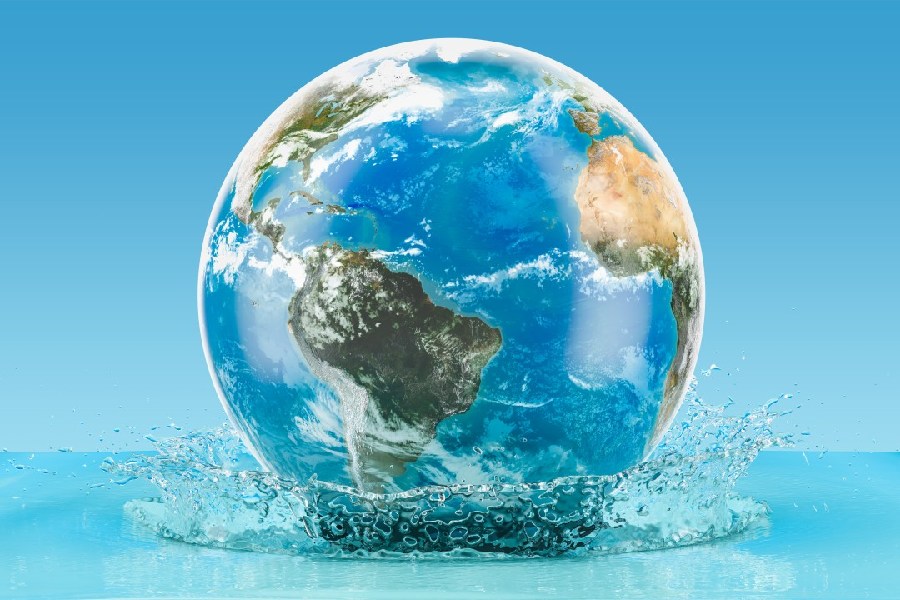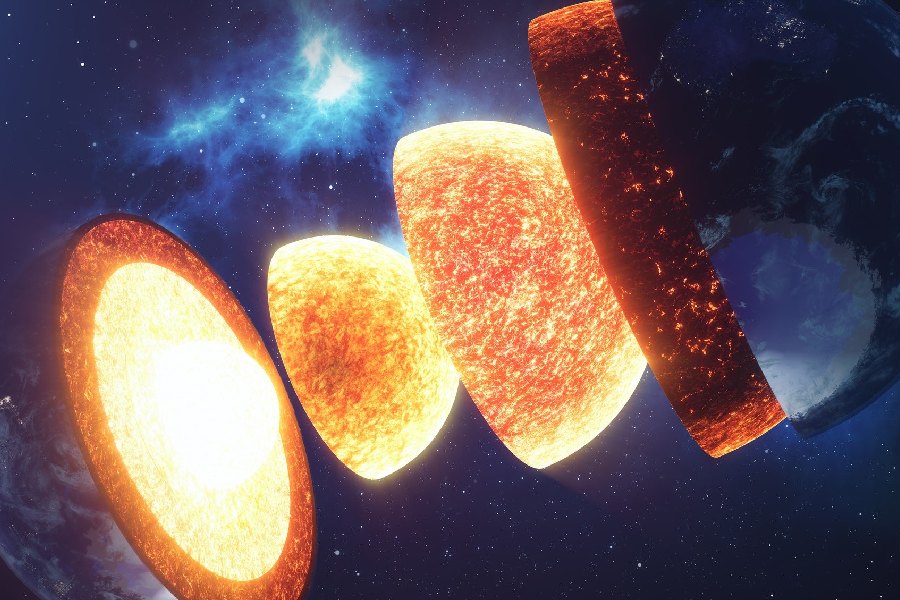Water, the lifeblood of our planet, covers over 70% of Earth’s surface. It’s hard to imagine our world without this essential compound, from the vast oceans to the tiniest droplets in the clouds. But how did Earth get water? Will Earth run out of water?
As we dive into the fascinating theories and evidence surrounding the origins of Earth’s water, we’ll discover a complex and captivating story. From the violent beginnings of our planet to the intricate interplay of cosmic forces, the journey of water on Earth continues to unfold.
So, join us as we explore the leading hypotheses, examine the latest scientific findings, and piece together the elusive puzzle of how water originated on Earth.

How Did Earth Get Water?
The presence of water on Earth is believed to have originated from different sources. However, there are two theories that talk about the origin of water in the Eart. The first one is that the Earth was born with the molecular precursors of water already present. The second one includes water-laden space rocks, like comets and asteroids, which brought water after the planet’s formation.
Further, the theories explain how, during Earth’s early years, intense volcanic activity released water vapor and other gasses trapped within the planet. As the surface cooled, water vapor condensed into clouds and fell as rain, forming oceans.
Additionally, icy bodies bombarded Earth, contributing more water. This combination of processes over billions of years led to Earth’s abundant water formation.
Hypotheses and Theories on Earth’s Water Formation
As mentioned, leading theories suggest that Earth’s water originates from various sources. One theory proposes that ice-rich comets and meteorites bombarded the early Earth, depositing significant amounts of water. However, some geological evidence raises doubts about whether comets alone could have provided enough water.
Another theory, known as the indigenous theory, suggests that Earth formed from minerals and clays already containing water. However, the early water likely evaporated due to high temperatures. It’s also possible that volcanic eruptions released water vapor from hydrated minerals underground, gradually contributing to the formation of oceans.
The modern perspective combines these theories, suggesting that later additions from comet impacts and outgassing likely supplemented primordial water within mineral compositions. Yet, no single source can fully explain the presence of Earth’s oceans.
The current consensus among scientists supports a synthesis of these mechanisms. Primordial water existed during Earth’s formation, and additional water from various sources over time created the vast oceans that distinguish our planet.
Early Earth conditions and water delivery
Early Earth, formed violently over 4.5 billion years ago, sported a molten surface. The planet was engulfed in volcanic gases, enduring intense heat and frequent meteorite impacts that hindered the presence of surface water. Consequently, the age of water on Earth is a matter of inquiry.
Evidence suggests that despite these challenges, oceans may have existed as early as 4.4 billion years ago. Given the absence of surface water on early Earth, external delivery mechanisms were essential. Leading models propose collisions with icy bodies as a plausible scenario.
Comets and asteroids are considered potential sources of water through bombardment. Additionally, volatile-rich planetesimals merging with early Earth might have contributed to its water content.
Carbonaceous chondrite meteorites carry evidence of delivering water to Earth and other inner planets. Isotopic studies also support the notion of comets and planetesimals as external sources, likely originating from beyond the Frost Line in the past.
Although early conditions posed challenges for the presence of surface water, current models indicate that icy bodies from space provided the necessary external contribution. These models align with geological records.
Solar System’s water distribution
Water is present across the Solar System, yet its presence differs depending on the location. Water is generally scarce in the inner Solar System, particularly within the Asteroid Belt.
The terrestrial planets experienced a loss of lighter elements, such as hydrogen, during their formation. However, Earth stands out as an exception, possessing a significant amount of surface water compared to other inner system bodies.
In contrast, the outer Solar System contains much more water. This is particularly evident beyond the Frost Line, where icy bodies formed and endured in the colder environment.
Gas giants like Jupiter and Saturn likely possess atmospheric water. Additionally, bodies like dwarf planets, moons, comets, and objects in the Kuiper Belt in the outer Solar System often contain substantial amounts of water ice.
The distribution of water correlates with the temperatures experienced during formation. The water scarcity in the inner system sharply contrasts with its abundance in icy bodies beyond the Frost Line.
This correlation helps to elucidate theories regarding the origins of Earth’s water. It suggests that an external source contributed water, aligning with isotopic signatures in objects formed in the cooler regions farther from the Sun.
Understanding Water’s Abundance and Distribution
The abundance of liquid water on Earth’s surface is closely tied to volcanic and tectonic activity. As magma rises from the mantle and erupts from volcanoes, dissolved water vapor is released through outgassing and degassing. This adds water to the atmosphere and surface over geological timescales.
However, this raises an interesting question: does the Earth make new water in this process, or is it simply recycling existing water? The answer is complex. While the total amount of water on Earth likely remains fairly constant, volcanic outgassing can release new water molecules through chemical reactions within the mantle.
The movement of tectonic plates also plays a crucial role in Earth’s water cycle. At oceanic spreading ridges, seawater penetrates the hot new oceanic crust. This adds water to the rock.
In subduction zones, oceanic plates dive underneath continental plates. Huge amounts of water are carried deep into the mantle, bound in minerals within the sinking slab.
This water is later returned to the surface during arc volcano eruptions, completing the recycling of Earth’s water. The continual refreshment and recycling of water at the surface are sustained through volcanic and tectonic processes.

Compositional Analysis of Earth’s Water
The distinct isotopic fingerprints of Earth’s water provide clues about its origin sources. The ratio of deuterium, a heavy hydrogen isotope, to regular hydrogen in Earth’s water does not precisely match that of water in comets, asteroids, or protostellar clouds.
This suggests Earth’s water has mixed origins. It may incorporate water from the early mantle and perhaps small cometary contributions over time. Earth’s surface water also contains dissolved atmospheric gasses, salts, and minerals. This gives it a complex chemical profile that varies across reservoirs.
Furthermore, subsurface oceans suspected to exist on icy moons like Europa and Enceladus show deuterium-to-hydrogen ratios. These ratios substantially deviate from Earth’s values. With additional data on isotopic signatures, densities, salinities, and impurity levels, better constraints can be made about the distinct genesis of Earth’s water.
This is relative to the other ocean worlds that host dynamic, cycling liquid water reservoirs. Clarifying the comparative compositions aids the search for possible habitats beyond our home planet.
Water reservoirs and distribution
The global water network
Water is essential for life and is stored across Earth in a vast network of reservoirs. Picture the oceans as immense water tanks, containing 97% of the planet’s water, maintaining stable conditions for thousands of years, ideal for supporting marine life.
On land, freshwater is more dispersed. Rivers, lakes, and shallow groundwater constitute a smaller portion, yet they are vital for sustaining life on Earth’s surface.
Beneath the surface lies a different landscape. Deep underground, water moves slowly through rock pores and fractures over millions of years, interacting with minerals and shaping the Earth’s interior.
The dynamic force of water
The network of water reservoirs is more than just storage; it’s a dynamic force. Water, abundant and essential, filters through the Earth’s crust, shaping tectonic plate movements and volcanic activity—processes that have shaped continents for billions of years.
The interconnected water systems on Earth’s surface are crucial for maintaining habitability. Even slight alterations in ocean currents and atmospheric circulation can greatly affect water distribution, influencing regional climates and the delicate balance of food chains. The significance of this global water network, both geologically and biologically, cannot be overstated.
Recent Research and Ongoing Studies
Cutting-edge techniques are being used to study where Earth’s water comes from and how it moves. Spacecraft with special instruments explore icy moons and Mars, looking for hidden oceans. They’re also comparing what they find to Earth.
In laboratories, scientists simulate how water interacts with rocks deep inside the Earth. They’re doing this at extreme temperatures and pressures over long periods. This helps them understand how water moves around inside the Earth.
Researchers also use isotopic fingerprinting to study water samples from volcanoes, mid-ocean ridges, and comets. They use precise instruments to analyze the samples. This aids them in determining the origins of Earth’s water.
Computer models are combining large amounts of data from different fields of science. They simulate how Earth’s atmosphere and oceans changed over time as life appeared. All of these studies are helping scientists get a better understanding of how Earth’s water system works and how everything is connected.
Future directions in understanding Earth’s water origin
The quest to understand Earth’s water remains ongoing. Scientists explore “ocean worlds” in our Solar System—moons with hidden oceans under icy surfaces—and seek exoplanets where liquid water might exist, sparking excitement.
Spacecraft equipped with advanced gravity sensors and altimetry tools delve into these icy moons, collecting data on their subsurface oceans. Scientists aim to uncover clues about water’s origins by comparing these alien oceans to Earth’s.
On Earth, the search continues with increasingly precise isotope measurements. These measurements analyze the ratios of different elements within water molecules, akin to a unique fingerprint.
Conclusion
How did Earth get water? The synthesis of various hypotheses and theories suggests that Earth’s water likely originated from multiple sources, including comets, asteroids, and indigenous minerals.
While water distribution across the Solar System offers insights into its origins, Earth’s unique abundance of water compared to neighboring planets remains fascinating. The ongoing research, employing cutting-edge techniques ranging from spacecraft exploration to laboratory simulations and isotopic analysis, deepens our understanding of Earth’s water system.
As scientists delve deeper into “ocean worlds” within our Solar System and search for exoplanets harboring liquid water, this quest’s excitement remains palpable. With each discovery and technological advancement, scientists come closer to unraveling how Earth acquired its life-sustaining water.
